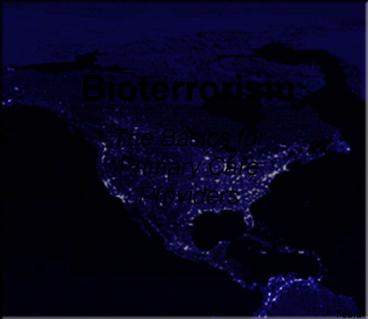Bioterrorism PowerPoint PPT Presentation
1 / 27
Title: Bioterrorism
1
Bioterrorism The Basics for Primary Care Providers
5/9/01
2
Bioterrorism
- The use, or threatened use, of a micro-organism
or the product of a micro-organism in order to
generate fear, morbidity or mortality in a
population.
3
CDC Category A Agents
4
CDC Category A Agents
5
CDC Category A Agents
- High morbidity or mortality
6
CDC Category A Agents
- High morbidity or mortality
- Relative ease to produce, store, and disperse
7
Bioterrorism Agents
- Category A Diseases
- Anthrax (Bacillus anthracis)
8
Bioterrorism Agents
- Category A Diseases
- Anthrax (Bacillus anthracis)
- Smallpox (variola virus)
9
Bioterrorism Agents
- Category A Diseases
- Anthrax (Bacillus anthracis)
- Smallpox (variola virus)
- Plague (Yersinia pestis)
10
Bioterrorism Agents
- Category A Diseases
- Anthrax (Bacillus anthracis)
- Smallpox (variola virus)
- Plague (Yersinia pestis)
- Tularemia (Francisella tularensis)
11
Bioterrorism Agents
- Category A Diseases
- Anthrax (Bacillus anthracis)
- Smallpox (variola virus)
- Plague (Yersinia pestis)
- Tularemia (Francisella tularensis)
- Botulism (botulinum toxin)
12
Bioterrorism Agents
- Category A Diseases
- Anthrax (Bacillus anthracis)
- Smallpox (variola virus)
- Plague (Yersinia pestis)
- Tularemia (Francisella tularensis)
- Botulism (botulinum toxin)
- Viral Hemorrhagic Fever
13
Delivery Mechanisms
- Aerosol route
- Easiest to disperse
- Highest number of people exposed
- Most infectious
- Undetectable to humans
14
Delivery Mechanisms
- Aerosol route
- Easiest to disperse
- Highest number of people exposed
- Most infectious
- Undetectable to humans
- Food / Waterborne less likely
- Larger volumes required
- More technically difficult
15
Roles of Clinicians
- General Concepts
16
Roles of Clinicians
- General Concepts
- High level of suspicion
17
Roles of Clinicians
- General Concepts
- High level of suspicion
- Hoofbeats could be a zebra
18
Roles of Clinicians
- General Concepts
- High level of suspicion
- Hoofbeats could be a zebra
- Unusual epidemiologic trends
19
Roles of Clinicians
- General Concepts
- High level of suspicion
- Hoofbeats could be a zebra
- Unusual epidemiologic trends
- Case clustering
20
Roles of Clinicians
- General Concepts
- High level of suspicion
- Hoofbeats could be a zebra
- Unusual epidemiologic trends
- Case clustering
- Severe, fulminant disease in otherwise healthy
21
Roles of Clinicians
- General Concepts
- High level of suspicion
- Hoofbeats could be a zebra
- Unusual epidemiologic trends
- Case clustering
- Severe, fulminant disease in otherwise healthy
- Unusual for the region
22
Roles of Clinicians
- General Concepts
- High level of suspicion
- Hoofbeats could be a zebra
- Unusual epidemiologic trends
- Case clustering
- Severe, fulminant disease in otherwise healthy
- Unusual for the region
- Similar disease in animals
23
Roles of Clinicians
- For specific Bioterrorism (BT) diseases
- Recognize typical BT disease syndromes
24
Roles of Clinicians
- For specific Bioterrorism (BT) diseases
- Recognize typical BT disease syndromes
- Perform appropriate diagnostic testing
25
Roles of Clinicians
- For specific Bioterrorism (BT) diseases
- Recognize typical BT disease syndromes
- Perform appropriate diagnostic testing
- Initiate appropriate treatment/prophylaxis
26
Roles of Clinicians
- For specific Bioterrorism (BT) diseases
27
Roles of Clinicians
- For specific Bioterrorism (BT) diseases
- Report suspected cases to proper authorities
- 1) Local health department
- 2) Hospital epidemiologist
- 3) Infectious Disease consultants

